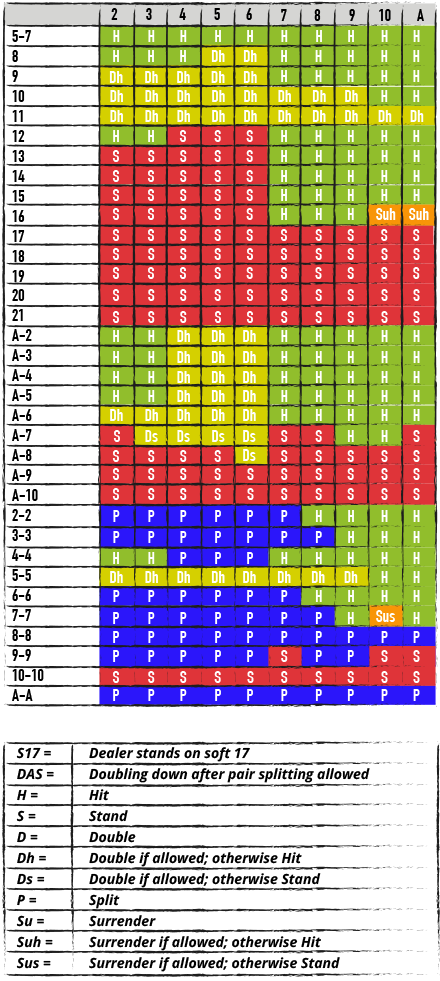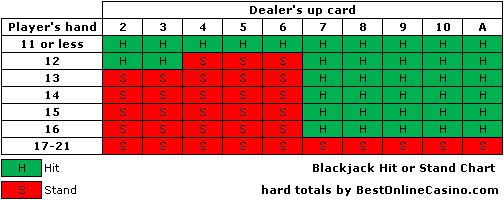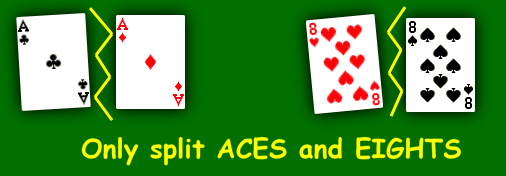Hit Stand Double Down And Split In Blackjack
They were part of a 1950s group that discovered that strategy could reduce the house edge to almost zero in blackjack. Now a typical strategy involves the following sequence of playing decisions: one decides whether to surrender, whether to split, whether to double down, and whether to hit or stand. First and foremost, most versions of blackjack would allow only one card to be dealt to each of the split hands. After that, the two hands automatically Stand and are compared to the dealer’s hand. The best scenario, in this case, is receiving 10-value cards (10, J, Q, or K) to your split Aces for a total of 21.
- When To Hit In Blackjack
- Double Down In Blackjack Meaning
- Hit Stand Double Down And Split In Blackjack Machine
In order to signify that you wish to double down your hand, place an additional amount of chips equal to or less than your original wager beside the original wager on the blackjack table. This is the universally accepted method of doubling down. The dealer will recognize that you wish to double down and will deal you an additional card. Blackjack - Hit, Stand, Double Down or Split? Blackjack is one of the best loved card games in the world. There are many variations, so if you're new to the game see How to Play Blackjack and Pontoon. Like any casino game, Blackjack is designed to return a profit to the dealer. However, against a reasonable skilled player this profit is very.
Splittingaces and eights is part of blackjackbasic strategy. Rules vary across gambling establishments regarding resplitting, doubling, multiple card draws, and the payout for blackjack, and there are conditional strategic responses that depend upon the number of decks used, the frequency of shuffling and dealer's cards. However, regardless of the various situations, the common strategic wisdom in the blackjack community is to 'Always split aces and eights' when dealt either pair as initial cards.[1] This is generally the first rule of any splitting strategy.[2]
Splitting[edit]
The object of blackjack is for a player to defeat the dealer by obtaining a total as close to 21 as possible without accumulating a total that exceeds this number.[3] In blackjack, the standard rule is that if the player is dealt a pair of identically ranked initial cards, known as a pair, the player is allowed to split them into separate hands and ask for a new second card for each while placing a full initial bet identical to the original wager with each. After placing the wager for the split hands the dealer gives the player an additional card for each split card. The two hands created by splitting are considered independently in competition against the dealer.[4][5] Splitting allows the gambler to turn a bad hand into one or two hands with a good possibility of winning. It also allows the player to double the bet when the dealer busts.[2] Some rules even allow for resplitting until the player has as many as four hands[4] or allow doubling the bet after a split so that each hand has a bet double the original.[6][7] The standard rules are that when a bet is doubled on a hand, the player is only allowed to draw one more card for that hand.[8][9]
Aces[edit]
A pair of aces gives the blackjack player a starting hand value of either a 2 or a soft 12 which is a problematic starting hand in either case.[2][10] Splitting aces gives a player two chances to hit 21.[11] Splitting aces is so favorable to the player that most gambling establishments have rules limiting the player's rights to do so.[2][10] In most casinos the player is only allowed to draw one card on each split ace.[8][10] As a general rule, a ten on a split ace (or vice versa) is not considered a natural blackjack and does not get any bonus.[6] Prohibiting resplitting and redoubling is also common.[2] Regardless of the payout for blackjack, the rules for resplitting, the rules for doubling, the rules for multiple card draws and the dealer's cards, one should always split aces.[10][12][13]
Eights[edit]
If a player is dealt a pair of eights, the total of 16 is considered a troublesome hand. In fact, the value 16 is said to be the worst hand one can have in blackjack.[10] Since sixteen of the other fifty cards have a value of 10 and four have a value of 11, there is a strong chance of getting at least an 18 with either or both split cards. A hand totaling 18 or 19 is much stronger than having a 16.[6] Splitting eights limits one's losses and improves one's hand.[10][11][12] Probabilistic research of expected value scenarios shows that by splitting eights one can convert a hand that presents an expected loss to two hands that may present an expected profit or a reduced loss, depending on what the dealer is showing.[14] A split pair of eights is expected to win against dealer upcards of 2 through 7 and to lose less against dealer upcards of 8 through ace.[15] If a player hits on a pair of eights, he is expected to lose $52 for a $100 bet. If the player splits the eights, he is expected to lose only $43 for a $100 bet.[16]
History[edit]

Blackjack's 'Four Horsemen' (Roger Baldwin, Wilbert Cantey, Herbert Maisel and James McDermott), using adding machines, determined that splitting eights was less costly than playing the pair of eights as a 16.[17] They were part of a 1950s group that discovered that strategy could reduce the house edge to almost zero in blackjack.[18] Now a typical strategy involves the following sequence of playing decisions: one decides whether to surrender, whether to split, whether to double down, and whether to hit or stand.[19]
One of the earliest proponents of the strategy of splitting eights is Ed Thorp, who developed the strategy on an IBM 704 as part of an overall blackjack strategic theory published in Beat the Dealer: A Winning Strategy for the Game of Twenty-One in 1962.[18][20][21] Thorp was the originator of the card counting system for blackjack.[18]
Notes[edit]
- ^Gros, p. 60
- ^ abcdeOrtiz, p. 56
- ^Gros, p. 48
- ^ abGros, p. 51
- ^Jensen, pp. 22–23
- ^ abcSchneider, p. 47
- ^Gros, p. 52
- ^ abSchneider, p. 49
- ^Gros, p. 50
- ^ abcdefJensen, p. 53
- ^ abJensen, p. 56
- ^ abHagen and Wiess, pp. 68
- ^Schneider, p. 48
- ^Hagen and Wiess, pp. 66–67
- ^Scoblete, Frank. 'Why Splitting Eights At Blackjack Is An Iron Clad Rule'. Golden Touch Craps. Retrieved 24 July 2009.
- ^Tamburin, Henry (25 October 1999). 'Splitting Aces and Eights'. Casino city Times. Retrieved 24 July 2009.
- ^Snyder, Arnold (2005). 'Blackjack Basic Strategy: Aces and Eights'. Player Magazine (republished).
- ^ abcGros, p. 44
- ^Jensen, p. 51
- ^Thorpe, Beat the Dealer as cited in Snyder, Arnold citation below
- ^Levinger, Jeff (10 February 1961). 'Thorpe, 704 Beat Blackjack'(PDF). The Tech. Retrieved 30 May 2009.
References[edit]
- Dunki-Jacobs, Frits. Betting on Blackjack: A non-counter’s Breakthrough Guide to Making Profits at the Tables. Adams Media. pp. 28–34. ISBN1-58062-951-2.
- Gros, Roger. The Winner's Guide To Casino Gambling. Carlton Books Limited. pp. 44–69. ISBN1-85868-899-X.
- Hagen, Tom & Sonia Weiss (2005). The Everything Blackjack Strategy Book: Surefire ways to beat the house every time. Adams Media. pp. 66–68. ISBN1-59337-306-6.
- Jensen, Marten (2003). Beat Multiple Deck Blackjack. Cardoza Publishing. pp. 22–23, 51–56. ISBN1-58042-069-9.
- Ortiz, Darwin. Casino Gambling For The Clueless. Carol Publishing Group. pp. 55–59. ISBN0-8184-0609-7.
- Schneider, Meg Elaine. The Everything Casino Gambling Book (2nd ed.). Adams Media. pp. 47–49. ISBN1-59337-125-X.
- Thorp, Ed (1966). Beat the Dealer: A Winning Strategy for the Game of Twenty-One. Vintage. ISBN0-394-70310-3.
Many casino players lose big when they play blackjack, mainly because they don’t know how to play the game. Successful gamblers know how to bet, hit, stand, double down, split, or surrender. The typical gambler tends to stand when they should hit or refrain from splitting when they could have won more if they did.
One reason why people lose playing blackjack is that they don’t know basic strategy. Basic strategy was created using a computer simulation through millions of blackjack hands to show the mathematical probability of beating the dealer. The system works by telling the blackjack player what to do for every possible card combination.
Basic strategy is a blackjack strategy instrumental for what gamblers use to beat the dealer, card counting. It’s essential to understand basic strategy if gamblers want to win against the casino.
Basic strategy tells gamblers when they can hit, stand, double down, split pairs, or surrender to help increase their chances of winning. Because basic strategy is derived from a computer simulation where a computer is taught how to play blackjack and was told to play millions of hands in blackjack, gamblers can rest assured that the casino will be at a disadvantage as a result.
It is not a sure way to beat the dealer since players need to learn card counting to beat them. However, skipping basic strategy will keep gamblers from beating the casino since it’s the foundation to beat the game.
Basic strategy helps people win more money and lose less in the game. It provides the mathematically correct decisions a player should make to keep their losses low.
Gamblers need to memorize basic strategy perfectly if they want to use basic strategy. Not even knowing 80 or 90% of basic strategy is enough to use it, so people must fully memorize it. The gambler has to be intentional in learning this since they’ll have to commit basic strategy to memory if they want to win big and lose small.
It’s not easy to learn the strategy, but multiple websites aim to help gamblers understand basic strategy. There are different charts available to help people understand how to use basic strategy.
After learning basic strategy, gamblers will need to learn more blackjack rules and deviations relating to the game’s specific rules. Learning basic strategy first lets people have an easier time transitioning to other rules-specific charts.
Memorizing basic strategy may prove difficult; fortunately, some websites help people have an easy time remembering basic strategy rules. The following are the rules to remember for basic strategy.
Surrenders:
– 16 surrenders against dealer 9 through ace, or else don’t surrender
– 15 surrenders against dealer 10, or else don’t surrender
Splits:
– Always split aces
– Never split tens
– Two 9’s splits against dealer 2 through 9, except for 7, or else stand
– Always split 8’s
– Two 7’s splits against dealer 2 through 7, or else hit
– Two 6’s splits against dealer 2 through 6, or else hit
– Two 5’s doubles against dealer 2 through 9 or else hit
– Two 4’s splits against dealer 5 and 6, or else hit
– Two 3’s splits against dealer 2 through 7, or else hit
Two 2’s splits against dealer 2 through 7, or else hit

Soft totals
Any hand that has an ace where the ace counts as 11 to start.
– Soft 20 always stands
– Soft 19 doubles against dealer 6, or else stand
– Soft 18 doubles against dealer 2 through 6, and hits against 9 through ace, or else stand
– Soft 17 doubles against dealer 3 through 6 or else hit

– Soft 16 doubles against dealer 4 through 6 or else hit
– Soft 15 doubles against dealer 4 through 6 or else hit
– Soft 14 doubles against dealer 5 through 6 or else hit
– Soft 13 doubles against dealer 5 through 6 or else hit
Hard totals
Any hand that does not have an ace to start or has been dealt an ace can only be counted as 1.

– 17 and up always stands
– 16 stands against dealer 2 through 6 or else hit
– 15 stands against dealer 2 through 6 or else hit
– 14 stands against dealer 2 through 6 or else hit
– 13 stands against dealer 2 through 6 or else hit
– 12 stands against dealer 4 through 6 or else hit
– 11 always doubles
– 10 doubles against dealer 2 through 9 or else hit

– 9 doubles against dealer 3 through 6 or else hit
When To Hit In Blackjack
– 8 always hits
Double Down In Blackjack Meaning
Singaporean gamblers need only to register in a trustworthy Singapore casino to ensure that they can have a good time playing blackjack online. Register now at www.cm2bet.com and try playing our wide variety of casino games.
Hit Stand Double Down And Split In Blackjack Machine
Sources: